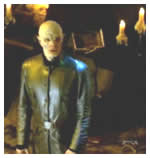« A Little Less Ritual |
Main
| Expansion »
February 06, 2003
OPINION
Big Bad
by Daniel Erenberg
The first time we met The Master, he was rising out of a pool of blood. His faithful minions surrounded him. The last time we met The Master, he was impaled, dead, gone, and never to be seen or heard from again (outside of alternate realities).
The first time we met The Master, he was rising out of a pool of blood. His faithful minions surrounded him. The last time we met The Master, he was impaled, dead, gone, and never to be seen or heard from again (outside of alternate realities).
 I was dumbfounded by The Master's sudden disappearance. As a long time comic book reader, I was used to a hero's archenemy remaining prominent throughout the run of a series. But here, Joss Whedon was killing off his major threat in the twelfth episode. I was dumbfounded by The Master's sudden disappearance. As a long time comic book reader, I was used to a hero's archenemy remaining prominent throughout the run of a series. But here, Joss Whedon was killing off his major threat in the twelfth episode.
This was a move that would become characteristic of Buffy The Vampire Slayer. Thinking about it now, though, I wonder why I ever thought different. Killing off one arch-villain and introducing a new one gives a show a sense of rebirth and renewal. With Buffy's way of using villains, each season has a sense of closure at the end and each season gets a fresh start at the beginning. It's almost as though each season is an insanely long movie.
The only problem with this is that the show has to get creative and not let its viewers long for the villains of yesteryear. Each year, Mr. Whedon has to create a new villain that one-ups the previous one.
These 'Big Bads', as the die-hard fans so affectionately call them, get more and more impossible each year. They get huger, more epic.
The first Big Bad was, of course, The Master. Played sardonically by the great character actor Mark Metcalf, The Master was a dark, creepy nemesis for the Slayer.
 It was important that the show would have a vampire as the first main villain because that particular species of demon was Buffy's primary target, but rather then just having a strong vampire (as in the original 1992 film), Joss created a more potent threat and a more demonic visage for the character. The Buffy mythos says that older vampires would have animalistic features. Joss gave The Master bat-like features. (This was again used with Kakistos's hooves in the season three episode 'Faith, Hope, and Trick'). It was important that the show would have a vampire as the first main villain because that particular species of demon was Buffy's primary target, but rather then just having a strong vampire (as in the original 1992 film), Joss created a more potent threat and a more demonic visage for the character. The Buffy mythos says that older vampires would have animalistic features. Joss gave The Master bat-like features. (This was again used with Kakistos's hooves in the season three episode 'Faith, Hope, and Trick').
The Master was a formidable opponent and even killed Buffy, albeit briefly.
Joss really upped the ante in season two by giving us multiple Big Bads. In 'School Hard', he introduced Spike and Drusilla, two characters that would have a lasting effect on the Buffyverse.
However, they were merely an opening act for the ultimate Big Bad. Angel lost his soul and became Angelus.
One of the good guys becoming evil, a theme later revisited in season six, set up the real memorable season two arc.
 Angelus started off with a bang, fighting his lover not quite to death in the middle of the mall. Angelus started off with a bang, fighting his lover not quite to death in the middle of the mall.
The second half of season two is one of the most brilliantly constructed story arcs ever to air on television. Angelus was evil personified.
He killed (Ms. Calendar, ingeniously), he tormented (most memorably Giles, by leaving the corpse of his lover in his bed), and he plotted, not only to kill Buffy, but also to destroy the world (with Acathla), a staple of all the best villains.
The third Big Bad, incredibly acted by Harry Groener, was Mayor Richard Wilkins III. The Mayor took the show up a notch. He was the first non-Vampire Big Bad and he was the Mayor of Sunnydale. After escaping the town over the summer, Buffy returned and was forced to almost fight her own town.
Another thing about the Mayor was that he was bigger than any of the other demons Buffy had previously faced. The Mayor's Ascension caused him to become a massive demon. He was huge. He killed Larry, Principal Snyder, and a load of extras. He was dispatched by blowing up the school. This was an epic villain.
But the question became, 'how was Joss going to follow this up?'
The answer: Adam.
Adam is a character who is, in my opinion unfairly, reviled by many fans of the show. Adam was the first villain who seemed so unstoppable that an arbitrary plot device had to be invented in order to kill him. Jane Espenson's 'Superstar' introduced the fact that Adam contained a 'uranium core'. Once said core was removed, Adam was gone for good. Adam was threatening and did his best to up the ante, but after stopping an unstoppable character, the Scooby Gang had to face their best menace yet.
After a super-demonic vampire, a good guy gone to the dark side, a majorly gigantic snake, and an invincible Hybrid creature, the season five Big Bad had to be huge. And it was. The fifth season's Big Bad was a God. This was the logical next step in the continuing impossibilities of the Buffy villains. Clare Kramer was delightfully daffy as Hell God Glory, tormenting the Scoobies with her trickery. She erased Tara's brain and kidnapped Dawn. She had loyal followers who referred to her as Glorificus, including the horrifyingly creepy Doc, played wonderfully by Joel Grey.
Joss found a far more satisfying way to kill off Glory than he did for Adam. Buffy actually sacrificed her entire life to put a stop to Glory's plans ('Little Miss Muffet counting down from 7-3-0').
In one of the best scenes ever on the show, Giles killed Glory. Reduced to her human form of Ben, Giles suffocated her, putting his hand over her mouth and grabbing her nose.
Season six was something of an oddity in that it didn't have a clear cut Big Bad. The answer to the burning question, 'who do you fight after a God', became a bit more clear.
The closest thing to a Big Bad in season six was the troika of Jonathan, Andrew, and Warren, three highly amusing but dreadfully unthreatening (except for the Tara murder) villains. Toward the end of the season, a second Big Bad was introduced.
In many ways, season six used the season two game plan:
It began with a red herring big bad (Spike and Dru-The Trio).
Its closing Big Bad was a good guy turned bad (Angel-Willow).
It ended with a Sarah McLachlan song.
Speaking of Dark Willow, I suppose I should comment on that.
While a formidable villain for the Scooby Gang, Dark Willow in no way raised the bar from the seasons before. She was evil and had an emotional downfall but, because she wasn't as powerful as what they'd faced in the past, I knew that the closing fight wouldn't be as severe and that the repercussions wouldn't be as dire.
The season seven Big Bad is The First Evil. The villainous cycle has finally come full circle. If this is, in fact, the final season of Buffy, then using the original evil is the most perfect way imaginable of closing things up. It's almost a compilation of Big Bads past as evidenced by the final scene of 'Lessons'.
Using a new arch-nemesis each year has served Buffy immensely well. This device makes the show feel fresh year after year. It's sort of the opposite end of the spectrum to Pokemon, to tell you the truth. That silly Japanese cartoon was an international phenomenon, but after dozens and dozens of episodes featuring the same two villains (Team Rocket, I believe it was?), the show got tired and lost its core fan base.
The Buffy spin-off Angel, tried a different route. They maintained a constant villain, Wolfram and Hart, for two years, but in the third season, they decided to keep Wolfram and Hart around while following in Buffy's footsteps and using season-long villains. Holtz in season three and The Beast in the current fourth season are threatening, evil, and great villains. Angel has adopted Buffy's system of villains and has become better for it.
Buffy The Vampire Slayer has had some extremely evil characters. As a colossal fan, I hope this is the last season. Why not make the last Big Bad the First?
Daniel Erenberg lives in a gothic-looking house in a suburb of Long Island shrouded by trees and darkness. His backyard is so overrun with shrubbery that he can't plant flowers in the soil. He's penned articles for numerous magazines (and a couple of websites for free). Currently, he's writing his first novel, entitled People That I've Long Since Forgotten. He's also written two plays, Little Room and Dystopia and a screenplay called Youth Or Consequence. He lives a fairly happy life alone and hankers constantly for the hour of eight P.M. to nine P.M. on Tuesday nights. You can contact Daniel on daniel@slayage.com. |
|



 I was dumbfounded by The Master's sudden disappearance. As a long time comic book reader, I was used to a hero's archenemy remaining prominent throughout the run of a series. But here, Joss Whedon was killing off his major threat in the twelfth episode.
I was dumbfounded by The Master's sudden disappearance. As a long time comic book reader, I was used to a hero's archenemy remaining prominent throughout the run of a series. But here, Joss Whedon was killing off his major threat in the twelfth episode. It was important that the show would have a vampire as the first main villain because that particular species of demon was Buffy's primary target, but rather then just having a strong vampire (as in the original 1992 film), Joss created a more potent threat and a more demonic visage for the character. The Buffy mythos says that older vampires would have animalistic features. Joss gave The Master bat-like features. (This was again used with Kakistos's hooves in the season three episode 'Faith, Hope, and Trick').
It was important that the show would have a vampire as the first main villain because that particular species of demon was Buffy's primary target, but rather then just having a strong vampire (as in the original 1992 film), Joss created a more potent threat and a more demonic visage for the character. The Buffy mythos says that older vampires would have animalistic features. Joss gave The Master bat-like features. (This was again used with Kakistos's hooves in the season three episode 'Faith, Hope, and Trick'). Angelus started off with a bang, fighting his lover not quite to death in the middle of the mall.
Angelus started off with a bang, fighting his lover not quite to death in the middle of the mall.